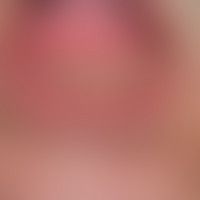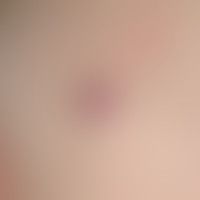Image diagnoses for "Nodules (<1cm)"
392 results with 1369 images
Results forNodules (<1cm)

Contact dermatitis allergic L23.0
Eczema, contact eczema, allergic. Acute contact allergy after application of a henna-containing tattoo.

Drug effect adverse drug reactions (overview) L27.0

Pyogenic granuloma L98.0
Granuloma pyogenicum (pyogenic granuloma): rapidly growing, shiny, erosive lump on the lower lip. The sudden appearance was preceded by a bite on the lower lip. At the base, increasing constriction with collar-like epidermis.

Pseudoxanthoma elasticum Q82.8
Pseudoxanthoma elasticum. multiple, chronically stationary, long-standing, netted and striped, slightly raised, yellowish papules. distortion of the skin texture in the relaxed neck area

Cornu cutaneum L85
Cornu cutaneum: existing for years, painful in certain foot positions and movements.

Cherry angioma D18.01
Angioma senile. red brown, very soft papules, almost completely compressible by finger pressure, 0.7 cm in size. therapy not necessary

Contagious mollusc B08.1
Molluscum contagiosa: multiple, 0.2-0.3 cm large, yellow-reddish, firm, shiny, completely asymptomatic nodules with characteristic central umbilical cord; appearing after first school swimming.

Nevus melanocytic (overview) D22.-
Common melanocytic nevus. type: Halo-nevus, almost complete regression of the melanocytic nevi, which are indicated as light brown spots in the middle of the pigment-less areas.

Nevus spitz D22.-
Naevus Spitz: rapidly growing, irregularly pigmented tumor on the knee of a 5-year-old girl.

Xanthogranulomas (overview) D76.3
Juvenile xanthogranuloma: with fresh consent from: Pajaziti L et al (2014) Juvenile xanthogranuloma a case report and review of the literature BMC Res Notes 7: 174

Lichen planus mucosae L43.8
Lichen planus mucosae. the histological changes are largely identical with those of the LP of the skin. dense lichenoid infiltrate (epitheliotropy usually not as pronounced as in lichen planus of the skin) mainly consisting of lymphocytes; compact orthohyperkeratosis with low parakeratosis.

Lupus erythematosus systemic M32.9
Systemic lupus erythematosus. acutely occurred facially emphasized symmetrical exanthema with disturbance of the general findings, medium-high fever, rheumatoid complaints. 10 year-old girl.

Sweet syndrome L98.2
Dermatosis, acute febrile neutrophils (Sweet syndrome): acutely occurring (existing since 1 week) highfebrile exanthema with involvement of the trunk, face and capillitium as well as the upper extremities. feeling of illness, myalgia, arthritis. high inflammation parameters. cause unknown (viral infection in combination with the intake of anti-inflammatory drugs?).

Granuloma anulare classic type L92.0
Granuloma anulare: Pronounced knot formation for several years. 54-year-old otherwise healthy woman.

Syphilide, ulcerous A51.3
Syphilis: multiple papular or papulo-necrotic, painless syphilis II, untreated!









